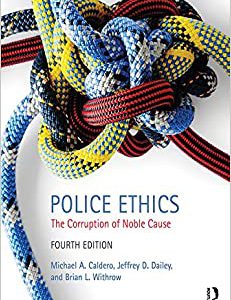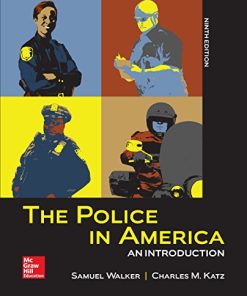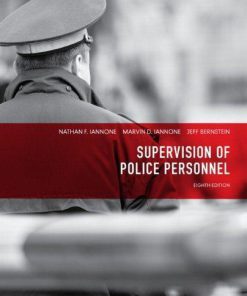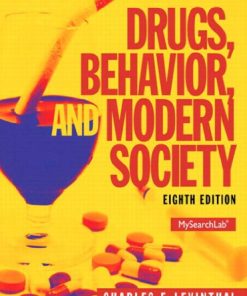(eBook PDF) Police & Society 8th Edition
$50.00 Original price was: $50.00.$25.00Current price is: $25.00.
(eBook PDF) Police & Society 8th Edition – Digital Instant Dowload.
(eBook PDF) Police & Society 8th Edition – Digital Instant Dowload.
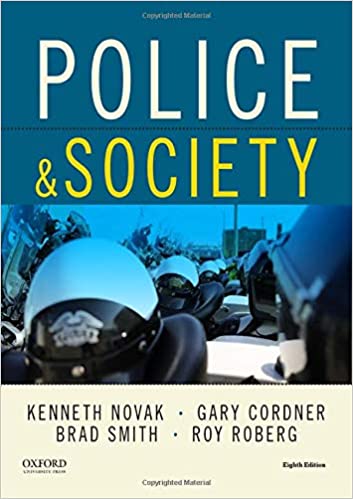
Product details:
- ISBN-10 : 0190940808
- ISBN-13 : 978-0190940805
- Author: Kenneth J. Novak.
Police & Society, Eighth Edition, offers an in-depth and analytical look at policing, from police behavior and organization to operations and historical perspectives. Focusing on the relationship between the police and the community and how it has changed throughout the years, the authors explore the most important theoretical foundations and incisive research on contemporary policing and show how that research is put into practice. The text is enhanced by extensive pedagogy and a unique chapter on higher education and policing.
Table contents:
PART I: POLICING FOUNDATIONS
Chapter 1. Police in a Democracy
Policing a Free Society
Police and Government
Police and Rule of Law
Police, Terrorism, and Homeland Security
Police Systems
The U.S. Police System
Other Types of Law Enforcement Agencies
Similarities and Differences
Police Role and Purpose
Law Enforcement or Politics?
Crime-Fighting or Social Service?
Proactive or Reactive?
Police Activities and Workload
Police Goals and Strategies
Looking Ahead
Summary
Chapter 2. Police History
Foundations of Policing
Early Policing
Policing in Nineteenth-Century England
The Emergence of Modern Policing in the United States
The First City Police Forces
The County Sheriff
Vigilance Committees
Modern American Policing
The Political Era
Police Development
Criticism in the Political Era
The Reform Era
Southern Colonial and Frontier Police Development: A Minority Perspective on the Development of American Police
State Police
Texas and Massachusetts
Pennsylvania
Highway Patrol
Federal Law Enforcement
The Revenue Cutter Service and the U.S. Marshal Service
Postal Inspectors
The Secret Service
The Federal Bureau of Investigation
Summary
Chapter 3. Legal Issues
Criminal Procedure
Searches and Seizures of Persons
Searches and Seizures of Property
Interrogations and Confessions
Civil Liability
Costs of Liability in Policing
Avenues of Liability
Civil Liability in State Courts
Civil Liability in Federal Courts
Emerging Liability Issues for the Twenty-First Century
Use of Force
Impact on Officers
Summary
Chapter 4. Police Strategies
Evolving Strategies of Policing
Landmark Studies of Police Effectiveness
Patrol Studies
Response Time Studies
Criminal Investigation Studies
Strategic Developments
Improving Crime-Control Effectiveness
Improving Police-Community Relations
Improving Professionalism
Developing Evidence-Based Practices
Strategic Alternatives
Community Policing
Problem-Oriented Policing
Intelligence-Led Policing
Predictive Policing
What Works in Policing
Summary
PART II: POLICE ADMINISTRATION
Chapter 5. Police Organization and Management
The Managerial Process
The Evolution of Police Management Classical Police Management Behavioral Police Management Contemporary Police Management
Organizational Design Criticisms of the Paramilitary Design Influence of Community Policing Structuring Police Discretion
Managing Police Performance Measuring What Matters Police Organizational Performance Police Unit Performance Supervision and Police Performance
Managing Group Behavior Police Subcultures Employee Associations and Unions
Managing Critical Incidents
Media Relations and Strategic Communications
Organizational Change Reorganizing Improving Leadership and Management Revising Policies and Procedures Changing Strategies and Tactics Changing Behavior and Culture
The Change Process Resistance to Change Overcoming Resistance to Change
Case Studies Madison, Wisconsin Chicago New York Los Angeles Cincinnati
Summary
Critical Thinking Questions References
Summary
Chapter 6. Selection and Development
Recruitment
Recruitment Methods
Recruiting for Diversity
Recruitment Toolkit
Selection
Preemployment Standards
General Suitability
Preemployment Testing
Recruit Screening Methods
Americans with Disabilities Act
Development
Recruit Training
Program Orientation
Philosophy and Instructional Methods
Curriculum Development and Content
Curriculum Updates
Effectiveness of Recruit Training
Field Training
Field Training Officer Program
Police Training Officer Program
Career Growth
Summary
Chapter 7. Field Operations: Foundations
The Patrol Function
Historical Development
Patrol Methods
Use of Patrol Resources
Proactive Arrests and Crackdowns
Police Pursuits
The Investigative Function
Historical Development
Selected Research on Investigative Operations
Crime Gun Intelligence Centers
Advances in Physical Evidence: The Automated Fingerprint Identification System and DNA
Bias Crime Programs
Detective-Patrol Relationships
Summary
Chapter 8: Innovations in Field Operations
Community-Based Approaches
Procedural Justice and Police Legitimacy
Broken Windows Policing
Place-Based Approaches
Focused Interventions
Hot Spot Policing
Gun Violence
Intelligence-Led Policing
Predictive Policing
Person-Based Approaches
Focused Deterrence Initiatives
What Works in Policing
Summary
PART III: POLICE BEHAVIOR
Chapter 9. Behavior and Misconduct
Perspectives of Police Behavior
Universalistic Perspectives
Particularistic Perspectives
Socialization Versus Predisposition
Early Examinations of Police Behavior
Decision Making and Police Discretion
Organizational Variables
Neighborhood Variables
Situational Variables
Individual (Officer) Variables
Police Deviance
Types of Deviance and Misconduct
The Prevalence of Police Deviance
Deviant Officers
The Persistence of Corruption
Are Gratuities a Type of Misconduct?
Police Sexual Misconduct
The Drug War and Police Deviance
Organizational Reponses
Summary
Chapter 10. Force and Coercion
Police-Citizen Interactions
Context of Force
National Estimates on Police Use of Force
Learning to Use Force
Training
Reengineering Training
Areas of Training
Police Culture and the Use of Force
Controversy and the Use of Force
Inappropriate Force
Brutality and Excessive Force
Physical and Psychological Force in Police History
Frequency of Excessive Force and Brutality
Brutality in the Twenty-First Century
Deadly Force
Category 1: Death
Category 2: Injury
Category 3: Noninjury
Individual and Situational Factors
Environmental and Departmental Variations
Racial Considerations
Legal and Policy Changes
Summary
Chapter 11. Accountability and Ethics
Internal Accountability Mechanisms
Bureaucratic Organization and Management
Internal Investigation
Issues in Internal Investigations
Early Warning/Early Identification Systems
Body-Worn Cameras
Effectiveness of Internal Investigations
External Accountability Mechanisms
Civilian Review
Police Auditor Systems
The Limits of Oversight Mechanisms
Professional Standards
The Police Professionalization Movement
Criteria of Police Professionalization
Ethical Standards
Ethical Perspectives
Ethical Dilemmas
The Limits of Professional and Ethical Standards
Summary
PART IV: CONTEMPORARY ISSUES
Chapter 12. Diversity and Inclusion
Racial Minorities in Policing
Unequal Treatment
Performance of African American Police
Women in Policing
Unequal Treatment
Performance of Women Officers
Affirmative Action
Equal Employment Opportunity
Increasing Diversity in Police Departments
Promotional Opportunities
Integration of Minorities and Women into Policing
Police Culture
Structural Characteristics
Sexual Harassment
Lesbian, Gay, Bisexual, and Transgender Officers
Future Prospects
Summary
Chapter 13. Stress and Officer Safety
The Concept of Stress
Occupational Stress
Overview of Stressors
Police Stressors
Emerging Sources of Stress
Line-of-Duty and Crisis Situations
Posttraumatic Stress Disorder
Shift Work
Social Supports and Police Stress
Consequences of Stress
Alcohol Abuse
Drug Abuse
Suicide
Stress and the Impact on Families
Policies and Programs
Officer Safety
Danger and Police Work
Improving Safety and Reducing Fatalities
Summary
Chapter 14. Higher Education
The Development of Higher-Education Programs for Police
Federal Programs and Support for Higher Education
Quality of Higher-Education Programs
Higher-Education Requirements for Police
The Impact of Higher Education on Policing
Higher Education and Attitudes
Higher Education and Performance
Higher Education and Use of Force
Higher Education and Promotion
Higher Education and Job Satisfaction
Higher Education and Terrorism
Validating Higher Education for Police
Higher Education as a Bona Fide Occupational Qualification
Higher Education and Discrimination
Higher-Education Incentive Programs
Higher-Education Requirements and Policy Implications
Moving Forward: Beyond Traditional University-Based Education?
Summary
Chapter 15. Emerging Issues
Changes in American Society
Generational Differences
Cultural Diversity
Immigration and Migration
Shifting Economics
Modern Problems
Crime Trends
Mass Shootings
Drugs
Mental Health
Modern Technology
Crime Detection and Crime Solving
Surveillance and Privacy
Officer Safety and Accountability
Social Media
Long-Term Trends
Professionalization
Privatization
Federalization
Militarization
Terrorism and Homeland SecuritySummary
Voices from the Field: Biographical Sketches
Glossary
Name Index
Subject Index
You may also like…
Uncategorized
Social Science
Uncategorized




